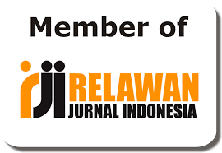Module development with treffinger model settings in class IX mathematics learning
Pengembangan modul dengan setting model treffinger dalam pembelajaran matematika kelas IX
Abstrak
The limitations of teaching materials in mathematics education pose a challenge in the field of education, hindering students from grasping mathematical concepts. Schools often rely solely on printed textbooks and workbooks as learning resources, lacking engaging and effective teaching materials to help students understand and enjoy mathematics lessons. This research is conducted in response to the existing issue, which is the lack of engaging and effective learning resources in teaching transformation topics to 9th-grade students at MTsN 5 Kota Padang. The study aims to develop a learning module that utilizes the Treffinger model and meets the standards of validity and practicality. The research method employed is the ADDIE model, which involves analysis, design, development, implementation, and evaluation phases. Research instruments include validation sheets, practicality questionnaires, and interview guidelines. The results of the research indicate that the developed module has an average validity rate of 92.36% and an average practicality rate of 91.33%, demonstrating that the module meets the required standards of validity and practicality in the context of learning.
##plugins.generic.usageStats.downloads##
Referensi
Anwar, M. N., Aness, M., Khizar, A., Naseer, M., & Muhammad, G. (2012). Relationship of Creative Thinking with the Academic Achievements of Secondary School Students. International Interdisciplinary Journal of Education, 1(3), 44–47.
Aswirna, P. (2018). Application Of Treatment Trait Interaction To Improve Learning Of Chemistry. SHS Web of Conferences, 42, 00114. https://doi.org/10.1051/shsconf/20184200114
Elvita, R. M., Yulia, Y., & Utami, N. P. (2022). Tingkat Berpikir Kreatif Peserta Didik SMPN 3 Ranah Pesisir dalam Menyelesaikan Soal Cerita pada Materi Aritmatika Sosial Kelas VII. Math Educa: Jurnal Matematika Dan Pendidikan Matematika, 6(1), 29–39. http://ejournal.uinib.ac.id/jurnal/index.php/matheduca
Fausih, Moh., & Danang, T. (2014). Pengembangan Media E-Modul Mata Pelajaran Produktif Pokok Bahasan “Instalasi Jaringan LAN (Local Area Network)” untuk Siswa Kelas XI Jurusan Teknik Komputer Jaringan di SMK Negeri 1 Labang Bangkalan Madura. Jurnal Mahasiswa Teknologi Pendidikan, 4(3), 1–9.
Ingersoll, G. M. (1974). An Instruction Decision-Making Model for Individual Differences in Reading. Journal of Reading Behavior, 6(1), 77–88.
Lestari, A. K. (2019). Pengembangan Modul Trigonometri Menggunakan Model Treffinger untuk SMK Kelas X [Skripsi]. Universitas Muhammadiyah Malang.
Lestari, E. P. (2018). Pengembangan Modul Pembelajaran Matematika dengan Model Setting Treffinger untuk Meningkatkan Hasil Belajar Peserta Didik pada Soal Cerita Bangun Ruang Kelas V MI Tarbiyatussibyan Boyolangu Tulungagung [Thesis]. IAIN Tulungagung.
Maulia, S. R., Retnowati, E., Mardika, F., & Fitriza, R. (2022). Efektivitas Pembelajaran Kolaboratif dengan Strategi Goal-Free Problems Ditinjau dari Kemampuan Transfer, Reasoning, dan Cognitive Load Siswa. Math Educa: Jurnal Matematika Dan Pendidikan Matematika, 6(2), 91–104.
Meyer, R. (1978). Designing Learning Modules for Inserrice Teacher Education. Centre for Advancement of Teaching.
Molenda, M. (2003). In search of the elusive ADDIE model. Performance Improvement, 42(5), 34–37. http://www.nwlink.com/~donclark/hrd/sat1.html#model.
Moma, L. (2017). Pengembangan Kemampuan Berpikir Kreatif dan Pemecahan Masalah Matematis Mahasiswa melalui Metode Diskusi. Cakrawala Pendidikan, 36(1), 130–139.
Munandar, U. (2004). Pengembangan Kreativitas Anak Berbakat (2nd ed.). Rineka Cipta.
Oka, A. A. (2010). Pengaruh Penerapan Belajar Mandiri pada Materi Ekosistem terhadap Keterampilan Berpikir Kritis dan Kemampuan Memecahkan Masalah Siswa SMA di Kota Metro. Bioedukasi, 1(2), 48–56.
Pehkonen, E., & Hannula, M. S. (2004). Mathematical Belief Research in Finland. Nordic Studies in Mathematics Education, 9(2), 23–38.
Purwaningsih, P. (2019). Pengembangan Modul Pembelajaran Berbasis ICARE (Introduction, Connection, Application, Reflection, Extention) pada Materi Statistika Siswa Kelas VIII SMP/ MTs [Skripsi]. UIN Raden Intan.
Purwanto, A., Nurjayadi, M., Suluya, R., & Ichsan, I. Z. (2020). EM-SETS: An Integrated E-Module of Environmental Education and Technology in Natural Science Learning. International Journal of Advanced Science and Technology, 29(03), 7014–7025.
Rahmawati, T. D. (2010). Kompetensi Berpikir Kritis dan Kreatif dalam Pemecahan Masalah Matematika di SMP Negeri 2 Malang [Tesis]. Universitas Muhammadiyah Malang.
Rosyadi, A. A. P. (2018). Pengembangan Modul Berbasis Riset pada Mata Kuliah Kalkulus untuk Meningkatkan Kreativitas Mahasiswa. Math Didactic: Jurnal Pendidikan Matematika, 4(2), 128–135. http://jurnal.stkipbjm.ac.id/index.php/math
Sepriyanti, N., Zulmuqim, Z., & Suryani, S. (2017). Efektivitas Model Pembelajaran Treffinger terhadap Kemampuan Pemahaman Konsep dan Pemecahan Masalah Matematis Peserta Didik Kelas VII SMPN 24 Padang. Math Educa: Jurnal Matematika Dan Pendidikan Matematika, 1(2), 129–141. http://ejournal.uinib.ac.id/index.php?journal=mej
Shoimin, A. (2014). 68 Model Pembelajaran Inovatif dalam Kurikulum 2013 (K. Rose, Ed.). Ar-Ruzz Media.
Siswono, T. Y. E. (2005). Student Thinking Strategies in Reconstructing Theorems. International Group for the Psychology of Mathematics Education, 4, 193–200.
Sternberg, R. J. (2003). Wisdom, Intelligence, and Creativity Synthesized. The Press Syndicate of the University of Cambridge.
Sternberg, R. J., & Lubart, T. I. (2014). The Concept of Creativity: Prospects and Paradigms. In Handbook of Creativity (pp. 3–15). Cambridge University Press. https://doi.org/10.1017/cbo9780511807916.003
Uloli, R., Probowo, P., & Prastowo, T. (2016). Kajian Konseptual Proses Berpikir Kreatif dan Pemecahan Masalah. Seminar Nasional Pendidikan Dan Saintek 2016: Isu-Isu Kontemporer Sains, Lingkungan, Dan Inovasi Pembelajarannya, 644–647.
Ulumuddin, A., & Wismanto, A. (2014). Bahan Ajar Bahasa Indonesia Ranah Sosial Budaya bagi Penutur Asing (BIPA). Jurnal Sasindo Pendidikan Bahasa Dan Sastra Indonesia, 2(1), 15–35.
Wahidin, D. (2009). Berpikir Kreatif.
Wirahayu, A. Y., Purwito, H., & Juarti, J. (2018). Penerapan Model Pembelajaran Treffinger dan Keterampilan Berpikir Divergen Mahasiswa. Jurnal Pendidikan Geografi: Kajian, Teori, Dan Praktik Dalam Bidang Pendidikan Dan Ilmu Geografi, 23(1), 30–40.





















